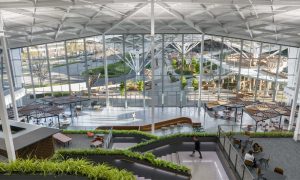Technology adoption and innovation in the Middle East building construction industry
There is a need for ubiquitous modern construction management technologies that can be accessed anywhere, anytime from the field. Hexagon’s HxGN SMART Build offers these advantages.

Sponsored content
Innovation hinges on adopting new technologies, and that requires education. While the Middle East building construction industry faces challenges to technology adoption, the region is well-positioned to accelerate the pace of innovation. Let’s explore how.
Industry Challenges
The construction industry is historically labour-intensive and lower on productivity than many other industries. For example, while manufacturing productivity has nearly doubled in recent years, productivity in construction has remained flat, or even declined.
Furthermore, waste in the building construction industry is a key area of concern. According to a study from the EU Commission, construction waste accounts for 25-30% of total waste.
These trends of low productivity and wastage also hold true for the Middle East, where some of the world’s largest building projects are currently underway. So why is that? One key reason is a lack of technology understanding and adoption.
For instance, Building Information Modeling (BIM) adoption in the Middle East building construction industry lags behind much of the developed world. There are many reasons for this. Firstly, before widespread adoption can happen, it’s important for all parties to understand what BIM involves. Contrary to popular belief, BIM is not a singular technology; it is a collaborative business process enabled by technology. Additionally, complexity of systems such as design authoring tools, scarcity of knowledge among expatriates and locals and many other factors prevent the use of such technology at construction sites. Finally, the current technology ecosystem is used mostly by one or more limited teams involved in a project lifecycle. This results in information silos as projects progress.
In reality, there is a need for collaborative technologies, in which everyone involved in a project has access to the same information. The owner, design consultant, PMC, general contractors and subcontractors can work together to ensure real-time information exchange, resulting in effective decision-making and increased ability to deliver projects on time and within budget.
Since this is generally not the case, it is not uncommon to see Middle East construction teams still rely largely on paper-based processes.
However, there is a way forward.
Technology as a Catalyst for Disruption
Change starts with recognition that technology can truly bring about disruption and boost productivity within the industry.
In a recent article from Strategy&, the author notes that technologies such as BIM are causing significant disruption in construction worldwide. This is shifting roles away from traditional skills, to include technological expertise and collaboration. Furthermore, as most key technical capabilities become commonplace across the industry, significant portions of design work have become commoditised. It is therefore essential that competitive differentiators focus primarily on productivity and efficiency. That’s why it is imperative for the Middle East to catch up technologically in order to compete globally.
The Changing Middle East Landscape
While the Middle East is lagging behind in technology adoption, steps are being taken by the industry and several governments to modernize the building construction industry and associated processes.
For example, Dubai’s government has moved toward improving productivity by mandating BIM on all construction projects having more than 20 floors, as well as those with areas larger than 200 thousand square feet or with unique features, such as those universities require.
Similarly, there are initiatives planned by other governments in the region, such as the Saudi Arabian government’s push on BIM, with tenders having specific BIM requirements. In addition, Qatar is promoting the use of BIM technology on all new rail projects.
Next-generation technology is also on the horizon, as it was recently announced that 3D printing will be used to build a Dubai skyscraper. Within the next five years, construction will begin on the property, which will be integral to supporting UAE’s goal to 3D print 25% of all new buildings by 2030.
BIM technology and 3D printing, along with additional building construction innovations in laser scanning, drone technology and machine control, all have the potential to boost construction productivity, increase margins and realise strategic objectives for the industry.
All this momentum indicates forward movement of technology adoption in the Middle East.
Collaborative, Connected Innovation
There is general recognition and agreement that technologies that connect stakeholders and inculcate collaboration are sustainable. Therefore, BIM practices need to go beyond just an office environment and integrate with on-site construction progress. This is an opportunity for building construction enterprises to evolve from just BIM to 5D BIM (model, schedule and cost) to truly improve outcomes and impact bottom lines. There is a need for ubiquitous modern construction management technologies that can be accessed anywhere, anytime from the field, using a browser or mobile device to connect to the office.
Hexagon’s innovative solution, HxGN SMART Build, offers these advantages. The solution streamlines building construction management by intelligently linking model, schedule and cost information to optimise construction planning and execution. The solution delivers real-time insight into construction progress — to those who need it, when they need it — to inform decisions that result in on-schedule and on-budget projects.
With technology adoption, the future of Middle East building construction looks exciting and promising. As Maxine N. Brenner, MD Investec Bank, rightly suggests, “Let’s make this technology a weapon for mass construction!”
Interact with Hexagon in the Middle East and help lead technology adoption! Click here to request a free HxGN SMART Build demo.
Sponsored content



















